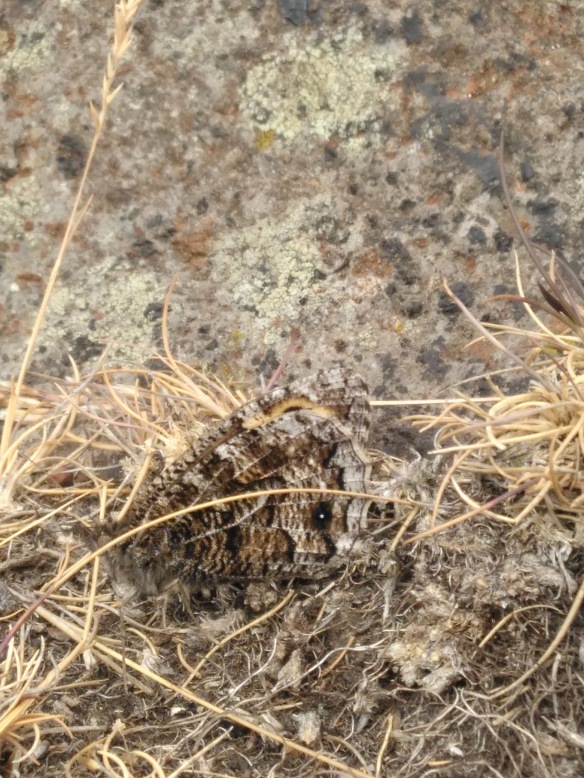Leafcutter bees are remarkable insects. Not only are they excellent pollinators but their nesting habits are truly extraordinary. Frustratingly, evidence of their activities, rather than sight of the bees themselves, are the nearest many of us get to them. Maybe it’s a bit like Oberammergau’s Passion Play, you know it’s there but seeing it is pretty tricky.

Patchwork Leafcutter Bee. Courtesy and copyright of gailhampshire from Cradley, Malvern, U.K / CC BY (https://creativecommons.org/licenses/by/2.0)
As with most solitary bees there is no maternal after-care for young leafcutter bees. Each spring the newly emerged females begin the job of preparing for the next generation almost immediately. Once mated, they select a potential nest cell in a hollow plant stem or similar cavity and, as their name suggests, the initial stage in preparing their nest is lining this with sections of leaves they have cut with their mandibles from plants. The structure has been said by many observers to liken the structure of a cigar or a small wrap.
This is the nest in which they lay a single egg and surround it with a nectar-pollen mix which the larva will feed on when it hatches. They will repeat this process until the hole is filled with multiple well-provisioned cells. And with that the adult females are off; job done.
The eggs hatch and the well-fed larvae will then pupate and overwinter in this individual cell until emerging as an adult the next spring or early summer. At that stage the whole process is on the cusp of starting again and once mated the females will live up to their leafcutter name with some urgency.
The fact is that the leafcutter bee’s handiwork, rather than they themselves, is most often seen. Think back to spotting little sections cut out of the likes of lilacs and rose leaves and what you probably observed was the work of the leafcutter bee. Now that you know, you can keep your eyes peeled for their neat, crescent-shaped trademark.
Gardeners should not fret if they stumble across evidence of the leafcutter bee at work. Misinformation and mistrust often stalks the common perception of insects. However, the amount trimmed is so small as to be of negligible impact on a healthy plant, certainly far less than a vigorous gardener might take in the course of enthusiastic action with a pair of secateurs. Plants don’t succumb in their wake.
So to the bee itself, or rather any one of the seven species you might encounter in the UK. They are dark coloured bees, often with orangey coloured hair, and they aren’t big with a wing span that never exceeds 1.5 cm.
If you are lucky enough to see a female carrying her prized leaf cutting back to her nest the sight is memorable as the leaf section is cleverly carried between her legs. It’s an incongruous site and one of nature’s moment that inevitably draws a smile from the watcher.
At Battleby we have had success with red mason bees using our bee houses, here’s hoping that perhaps leafcutters will be tempted as they are known to use man-made bee houses.
The pollination service provided by leafcutter bees is increasingly recognised. In North America they are known to pollinate alfalfa crops and it is said that they are more effective than the much better known and popularly revered honey bee. Their pollination service extends to garden plants so the presence of leafcutter bees in a garden should be celebrated rather than feared.
Leafcutter bees are indeed remarkable and one of the most engaging of our many solitary bees. But this is no Passion Play, and with luck you can view this spectacle every year.




 When they land though, the wings snap shut and the butterfly can literally disappear in front of our eyes. The undersides of the wings are a mix of grey-brown and light-coloured speckles that look just like gravel or stones. This corresponds incredibly well to the dry stony grasslands that this butterfly breeds in. There are even several recognised sub-species of this butterfly, some of which appear to be adapted to the particular types of plants and rocks of their habitats.
When they land though, the wings snap shut and the butterfly can literally disappear in front of our eyes. The undersides of the wings are a mix of grey-brown and light-coloured speckles that look just like gravel or stones. This corresponds incredibly well to the dry stony grasslands that this butterfly breeds in. There are even several recognised sub-species of this butterfly, some of which appear to be adapted to the particular types of plants and rocks of their habitats.








